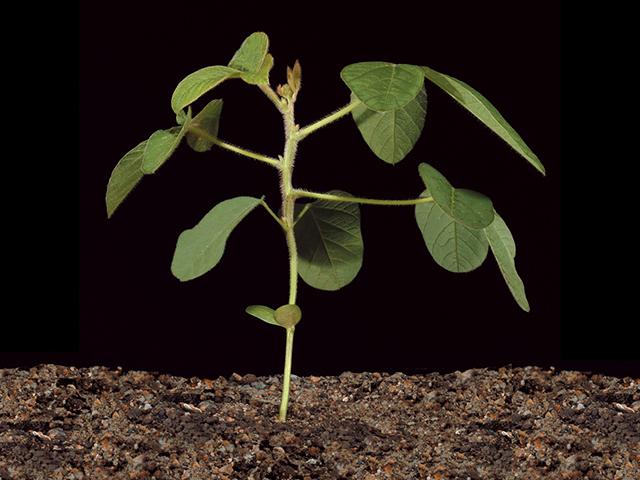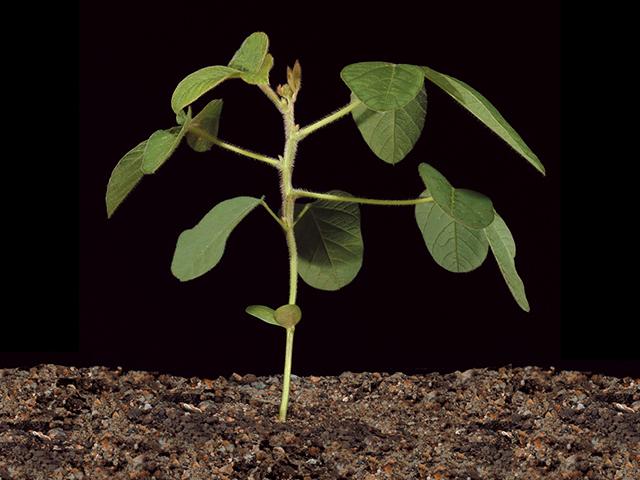Production Blog
Some States May Reach Dicamba Crop Stage Cutoff Before June 12
JEFFERSON CITY, Mo. (DTN) -- Though the EPA cutoff date for applying over-the-top (OTT) dicamba herbicides to soybeans in Illinois, Indiana and Iowa is still three weeks away, the application window may close for some early-planted fields well before then.
Back in February, EPA announced revised federal labels for XtendiMax, Engenia and Tavium herbicides, setting the application cutoff in Illinois, Indiana and Iowa at June 12 or the V4 growth stage, whichever came first. Thanks to advantageous field conditions this spring, many farmers were able to get a head start on the 2023 season. As a result, it's looking like applicators in these states may need to refer to the crop -- and not the calendar -- to determine when to stop applying OTT dicamba herbicides.
According to the latest USDA Crop Progress Report, both soybean planting and emergence are ahead of average in all three states where EPA added the growth stage restriction for dicamba. In Illinois, soybean planting was 85% complete for the week ending May 21. This was 27% ahead of the five-year average. In Iowa, 72% of the soybean crop was planted, 21% more than average, and in Indiana, 84% of soybean acres were planted, 18% ahead of average.
Similarly, soybean emergence was also well ahead of average. In Illinois, 57% of the soybean crop had emerged, 23% more than the five-year average. USDA estimated 43% of Iowa soybeans had emerged, 18% ahead of average, and in Indiana, 40% of the soybean crop had broken the surface, 15% more than average.
According to University of Minnesota Extension, once soybean plants emerge, on average they reach the V4 growth stage in about 25 days -- though with ideal conditions, that stage can be attained in a few as 12 days. Read more about soybean growth stages from here: https://extension.umn.edu/…. So, assuming average growing conditions, soybeans that emerged on May 18 would reach V4 on June 12 -- EPA's cutoff date. However, beans that emerged before May 18 could potentially reach the growth stage cutoff well before June 12. Applying OTT dicamba herbicides to those beans would constitute off-label application.
VISUALIZING V4
What does a V4 soybean look like? While there are a couple of methods used to determine vegetative and reproductive stages in soybeans, the V4 growth stage is characterized by the presence of four open trifoliate leaves growing from the main stem. A trifoliate is considered open when the leaflet's edges no longer touch. Soybean plants at the V4 stage are typically about 9-10 inches tall with five nodes on the main stem.
P[L1] D[0x0] M[300x250] OOP[F] ADUNIT[] T[]
A guide to soybean growth stages from University of Wisconsin Extension can be found here: https://coolbean.info/….
A video tutorial on determining soybean growth stages from Ohio State Agronomy can be found here: https://www.youtube.com/…
In letters announcing the dicamba label amendments in February, Lindsay Roe, chief of the Herbicide Branch within the EPA Office of Pesticide Programs' Registration Division, wrote that the registrants of three dicamba products registered for over-the-top use -- namely BASF, Bayer CropScience LP and Syngenta -- proposed the June 12 cutoff date for Iowa, Illinois and Indiana. Registrant-provided rationale for the date was based on a reduction in off-target movement as a result of decreased temperatures, reduced plant height earlier in the season, the opportunity for applications to be spread more evenly through the season and indications of improvement in Minnesota during the 2022 season using the June 12 cutoff date.
In addition to Illinois, Indiana and Iowa, other states also have revised federal labels for XtendiMax, Engenia and Tavium with the following prohibition for the 2023 season:
-- No spraying on dicamba-tolerant (DT) cotton in Iowa, Illinois and Indiana after June 12 or first square, whichever comes first.
-- No spraying on DT crops after June 20 in South Dakota.
-- No spraying on DT crops after June 12 south of Interstate 94 in Minnesota.
-- No spraying on DT crops after June 30 north of Interstate 94 in Minnesota.
-- No spraying when the forecasted high temperature exceeds 85 degrees Fahrenheit in Minnesota.
In addition to federal label revisions, Illinois also maintains state imposed restrictions that include no spraying when the forecasted high temperature on the day of application exceeds 85 degrees.
In all other states, the federal cutoff date for OTT dicamba application is June 30 on soybeans and July 30 on cotton.
Read more about previous dicamba label restrictions here: https://www.dtnpf.com/… and https://www.dtnpf.com/….
Jason Jenkins can be reached at jason.jenkins@dtn.com
Follow him on Twitter @JasonJenkinsDTN
(c) Copyright 2023 DTN, LLC. All rights reserved.






Comments
To comment, please Log In or Join our Community .